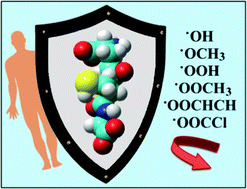Glutathione, which is the most abundant cytosolic thiol, plays important roles in the non-enzymatic antioxidant defence system. Its free radical scavenging activity towards radicals of different nature (·OH, ·OOH, ·OCH3, ·OOCH3, ·OOCHCH2 and ·OOCCl3) have been studied in aqueous solution, using the Density Functional Theory. It was found that the rate constants range from 2.02 × 104 M−1s−1 to diffusion limit (7.68 × 109 M−1s−1). Therefore it can be stated that glutathione is an excellent free radical scavenger, able of efficiently scavenging a wide variety of free radicals. It reacts exclusively by H transfer, and with the exception of its reaction with ·OH there is only one important channel of reaction, yielding to the S-centered radical. For the reaction with ·OH, on the other hand, a wide product distribution is expected, which explains the formation of C-centered radicals experimentally observed. Glutathione was found to be exceptionally good as a OOH radical scavenger, comparable to 2-propenesulfenic acid. This has been explained based on the strong H bonding interactions found in the transition states, which involves the carboxylate moiety. Therefore this might have implications for other biological systems where this group is present.

You have access to this article
 Please wait while we load your content...
Something went wrong. Try again?
Please wait while we load your content...
Something went wrong. Try again?


 Please wait while we load your content...
Please wait while we load your content...